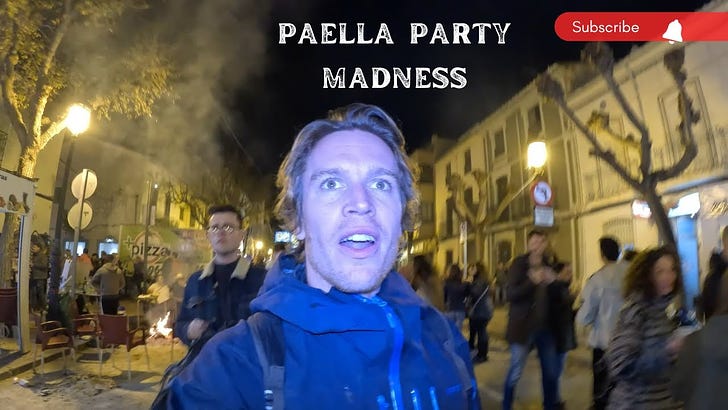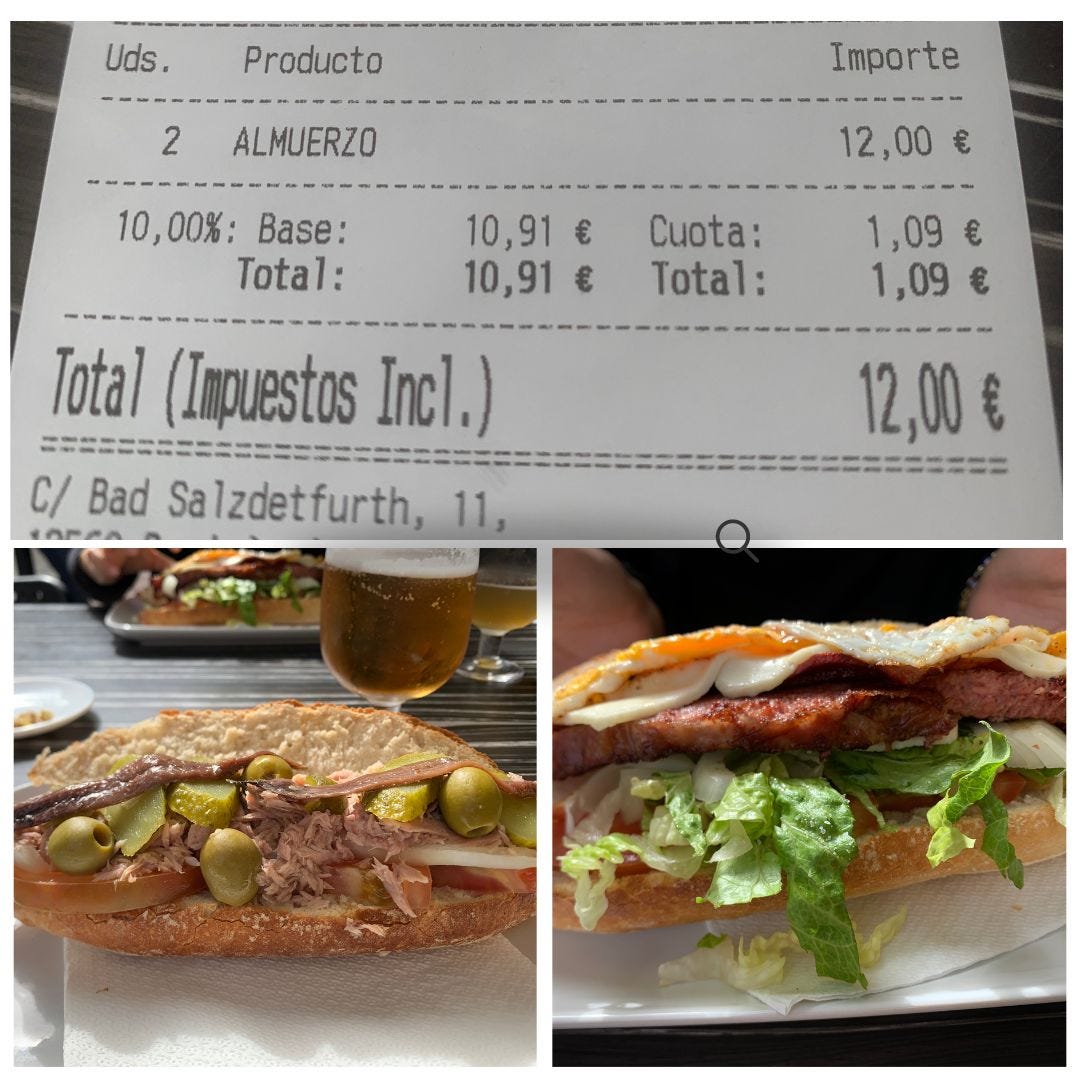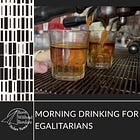Is Valencian Culture Right for You?
Paella, Mascletas, Cosmetic Surgery, Petardos (Firecrackers), Bocadillos (subs), Carajillos, and more.
Comunidad Valencia was the first home I chose for myself, and so far, the only.
I arrived during COVID, which sucked me into a kafkaesque bureaucratic nightmare. Businesses were suffering, festivities were limited, demons/bureaucrats toiled with people’s hearts or slept on the job, and yet, I bought an apartment thinking, “Inflation and real estate are going to skyrocket, and if I’m already happy here during COVID, I’ll definitely be happy after COVID.”
I was right.
Restaurants and businesses opened up, every saint was once again an excuse to party, prices went up, and I discovered what makes Comunidad Valencia’s culture inseparable yet distinct from the rest of Spain.
Let’s start with the basics.
Paella
In that video, you’ll learn that authentic Valencian paella is anything from “Bomba Rice, a pinch of paprika, saffron, rabbit, chicken and, bajoqueta (a flat green bean), tomato and locust bean” to “It’s about getting drunk with your friends.”
Alcohol & Parties
“It’s about getting drunk with your friends” is the most honest and consistent answer behind traditions and festivals in Valencia. Some might have you believe they’re about commemorating saints, the birthplace of a town, independence, and so on, but that’s just for trivial pursuits.
Valencians truly gained their reputation as fiesteros (party animals) in the 1980s and 90s when La Ruta del Bakalao—otherwise known as Destroy Route—really took off. It was the largest clubbing movement in Spain. Thousands of young people around the metropolitan area of Valencia would pop pills, snort cocaine, love, dance, and party their faces off every weekend.
Like the revealing cinema of Pedro Almodóvar, Vicente Aranda, Pedro Costa, Alejandro Amenábar, and Fernando Trueba, La Ruta del Bakalao was a response against the spiritual, sexual, and intellectual suppression Spanish people faced during the Francoist era.
Spanish legislation, particularly regarding nightlife, was still very immature due to the legacy of Francoism and was full of legal loopholes, which entrepreneurs of these nightclubs took advantage of. This was compounded by the lesser concern and information about drugs that existed in the country.
However, partying doesn’t always need to be a drug-and-electronic-music-ridden response to fascism. Sometimes, all you need is alcohol and a terrace—something people from any part of the political spectrum can enjoy.
Although Valencians love to party, they know how to pace themselves, unlike us belligerent savages up north. Many people come to Valencia (and the rest of Spain) thinking that wine is the go-to drink. Although they ferment Tempranillo (a grape with a fine balance between earth and fruit) by the tons, beer is the most popular. However, that’s not specific to Valencia.
The most Valencian drinks are Agua de Valencia, El Barrejat, and El Cremaet.
Agua de Valencia: This cocktail was created in 1959 by Constante Gil at Café Madrid in Valencia, but it became popular in Valencia. In addition to Valencian oranges, it includes cava, gin, vodka, ice, and sugar.
El Barrejat: My personal favourite. It’s a mixture of cazalla (a clear anís liquor) y mistela (sweet wine liquor).
El Cremaet: Alright, this is the most important one because I’ve seen people drink it daily in most places, whereas the other ones are a bit harder to find. There are different variations for making a Cremaet, but they all agree on one thing: "Only Valencians can make a real one." It's coffee with rum (or brandy) burned with honey (or sugar) and other additives like coffee beans, cinnamon sticks, and citrus peel.
And yes, this drink is totally acceptable in the morning. Which brings me to brunch and bread.
Bocadillos
There’s nothing like a €6 almuerzo (breakfast-brunch), including a bocadillo (sub), drink (which is usually beer), and coffee. In this case, from Nou Cafe in Bennicasim.
Many Valencians are known as paneros or paneras, which mean people who eat a lot of bread. That’s why you’ll find bocadillos everywhere (€4 - €7.50 is the usual price). And where is most of this bread baked?
In a ‘forn,’ which is Valenciano for ‘bakery.’ Here, you’ll also find:
Traditional Valencian Sweets
Panquemao: A brioche that is especially popular during Pascua (Easter).
Coca de llanda: A light sponge cake made with flour, sugar, eggs, oil, milk and lemon zest.
Pastelitos de boniato: Mini pasties filled with sweet potato paste.
Fartons, and to make it even more Valencian, Fartons with Horchata: A puffy elongated sweet bread with tiger nut milk.
Buñuelos de calabaza: Pumpkin donuts.
Frutas de Sant Donís: Colourful marzipans shaped like fruits.
Marzipan is not the only thing Valencians like to shape and mould…
Health and Vanity.
Valencia (the city, not the autonomous region) has the highest rate of aesthetic and reconstructive surgery operations per capita in Spain. Spain is the European country where the most surgeries are performed and is second in the world behind Brazil and the United States. In other words, Valencians are the Europeans most addicted to cosmetic surgery.
Okay, not really. We guiris (white-ass foreigners in Spain) definitely up those numbers because the quality-price ratio is one of the best in Europe.
Valencia is also one of the fittest cities in Spain. The city has one of the highest concentrations of gyms per capita in Spain, and I have never been to another region in Spain (or the world) with more outdoor calisthenic gyms.
Want to learn how to stay fit on the road? Message me for online coaching.
Mascletàs, Petardos, Noise, and Family.
Valencians love noise. You’ll find bars with three different channels (one of which is usually football) and music (mostly reggaeton-like shit) playing at the same time. And if that isn’t enough, kids (especially if they’re male) are free to scream as loud as they want, adults think a conversation is a competition for who can speak over you the loudest and cut you off the most, and it’s completely normal to play your YouTube video or voice message aloud while eating a meal.
But no, it doesn’t stop there. Fireworks during the day? Why not? That’s what Valencianos call a Mascaletà. These earth-shaking explosions of sound and slightly colourful smoke burst eardrums during events like Fallas, Magdalena, and other festivals during which entire cities turn into festival grounds for over a week.
Although the noise gives me migraines if I don’t drink several Barrejats, these festivals are why I respect Valencian culture. No matter the time of night, amount of drinks, topic of conversation, or whatever else pulls families apart in some cultures, brings them together in Valencia. You might see a four-year-old girl building a chain of petardos (firecrackers) around a dry bush while her grandfather passes her a match and her teenage brother is off dancing with his parents.
When those families invite me into their lives, I feel honoured. Sure, I don’t always understand them because, under family, they speak Valenciano, not Spanish, but that makes me feel all the more at home. By age three, I had already lived on three continents. Whenever family comes first, novelty and not knowing what the hell people are saying make me feel right at home.
This is why I can call comunidad Valencia a home… for now.
Want to know more about Without Borders?
Born Without Borders relies on paid subscriptions, not ads. Your support allows me to research, write, and live stories that help the inescapably foreign.
About Born Without Borders
Salir de las fronteras que impone tu mente. Who is Born Without Borders for? Anyone caught between cultures or ready to step outside their comfort zone with a quest. It’s for those who feel as inescapably foreign as I do. What do you get for subscribing?
Where am I going now?
For the next three to four months, I’m leaving this home behind while I explore the therapeutic benefits of slow travel on my quest through Europe to the North of Sweden. What will I find there? No clue. All I know is the calling to live this story as I write it down.
Along the way, I’ll write about the places and people I meet and dive into all aspects of travel therapy. But it all comes down to the quest. Like any relationship or good story, my journey can be a mirror to discover something new in yourself.
You might also like:









Just the other day I said I wouldn't mind a Agua de Valencia!
I wish I have this list when I visited Valencia years ago!